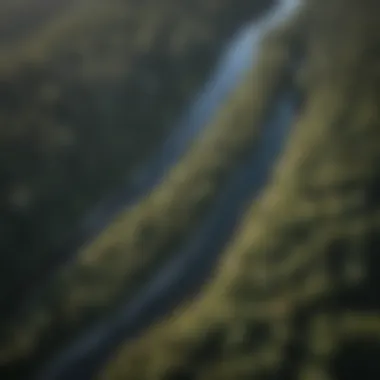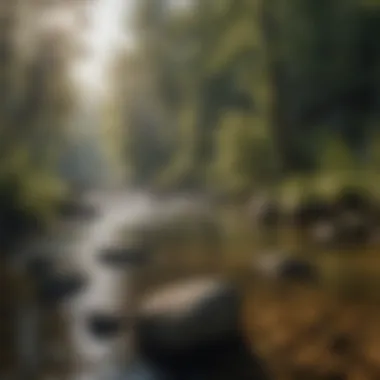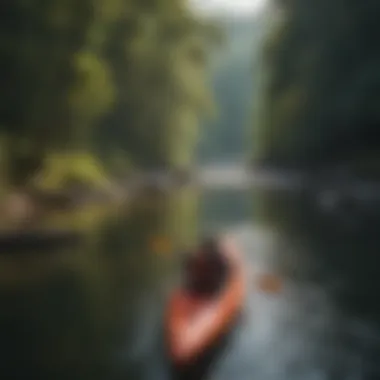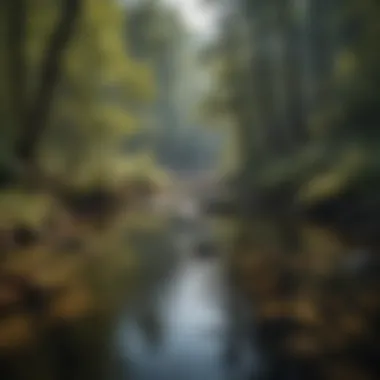Exploring the Chattooga River's History and Ecology


Intro
The Chattooga River, a living monument of natural beauty in the southeastern United States, is not just a playground for adventure-seekers. It embodies a rich tapestry of history, ecology, and cultural significance that deserves closer examination. As flows of crystal-clear waters wind their way through lofty mountains and dense forests, the river serves as both a cradle of life and a silent witness to the passage of time.
In this exploration, we will uncover the intertwined threads that shape the Chattooga's identity, examining the myriad ways in which it influences and is influenced by its environment. The journey begins by parsing the ecological aspects, which underscore the importance of the river as a vital component of regional biodiversity. Accordingly, we will delve into the practices of sustainable management that allow us to preserve this heritage for future generations.
The narrative will also touch upon the cultural imprint of the Chattooga, revealing how it informs local traditions, recreational activities, and a collective sense of stewardship for these cherished natural resources.
This meticulous exploration of the Chattooga River aims to not only educate but also inspire a deeper appreciation for one of nature’s significant waterways, ensuring its relevance, both historically and ecologically, endures.
Prolusion to the Chattooga River
The Chattooga River, a stunning waterway brimming with ecological diversity, serves as a vital thread in the fabric of both the natural landscape and the history of the region. Nestled in the Blue Ridge Mountains, it flows through parts of South Carolina and Georgia, contributing significantly to its surroundings. Understanding the importance of this river encompasses not just its geographical features, but also the historical narratives woven through its waters.
Geographical Location and Features
The Chattooga River meanders approximately 57 miles, originating in the Appalachian Mountains before slicing through dense forests and rocky terrains. Its winding path creates a vivid backdrop, marked by spectacular gorges, cascading waterfalls, and tranquil pools. The river itself serves as a natural boundary between South Carolina and Georgia, forming a rich habitat for various flora and fauna.
The river's watershed, which includes tributaries such as the Overflow Creek and the Little River, contributes to its high water quality and cool temperatures—ideal conditions for creating a lush ecosystem. Due to the elevation gradients in the surrounding terrain, the river experiences rapid twists and turns, with sections known for their exhilarating whitewater rapids, making it popular among adventure seekers.
In terms of accessibility, several entry points allow visitors to engage in recreational activities. From fishing to hiking, the Chattooga offers numerous opportunities for those looking to immerse themselves in nature. A standout feature is the nearby Chattooga River National Recreation Area, a haven for outdoor enthusiasts and conservationists alike.
Historical Significance
The history of the Chattooga River is as intricate as its flow. For generations, it has been a source of sustenance and culture for the indigenous peoples of the region. The Cherokee Nation, in particular, regarded the river as sacred. Beyond its natural beauty, it served practical purposes as a resource for food and transportation, fostering a deep spiritual connection with the land.
As settlers arrived in the 18th and 19th centuries, the significance of the river only grew. It became an essential route for commerce, allowing goods to flow in and out of the surrounding communities. The lush landscapes attracted timber workers, and the timber industry thrived alongside, although this eventually led to significant ecological changes.
"The Chattooga represents a bridge connecting past and present, where ecology and culture intersect, offering invaluable lessons about coexistence."
Moreover, the river gained recognition in popular culture, particularly for its portrayal in the film Deliverance, which sparked conversations about conservation and the preservation of such wild landscapes. Today, efforts continue to respect and honor the history, ensuring that the Chattooga remains not just a river but a symbol of life, struggle, and resilience in the face of environmental challenges.
The significance of the Chattooga River extends beyond its banks, touching on aspects of ecology, culture, and history that resonate deeply within the communities it serves. As we continue through this exploration, we will delve into its ecological diversity and cultural importance, revealing the layers of connection that define this extraordinary waterway.
Ecological Diversity of the Chattooga
The ecological diversity of the Chattooga River is a remarkable feature that not only sustains a rich tapestry of life but also provides critical benefits to the surrounding environment and local communities. This diversity stems from a unique blend of aquatic and terrestrial ecosystems that flourish along the river's banks, each playing a vital role in the overall health of the watershed. The river serves as a lifeline for numerous species, making it essential to understand its ecological complexity to foster appreciation and encourage conservation efforts.
Aquatic Ecosystems
The Chattooga's aquatic ecosystems are vibrant, housing freshwater that supports a variety of fish species, including the native Southern Appalachian brook trout. The river's cold waters create optimal conditions for the trout, which require well-oxygenated and clear streams for their lifecycle. These fish also serve as a crucial food source for larger predators, such as osprey and herons, weaving a complex web of interconnected life that enhances the river's biodiversity.
Additionally, the riverbed's structure, adorned with rocks and gravel, provides critical habitats for invertebrates that play a significant role in the nutrient cycle. As these organisms break down organic material, they help maintain water quality, which is vital for the health of all aquatic life. Furthermore, the riparian zones—edges along the river—support a mix of wetland plants such as cattails and water lilies that not only provide cover but also stabilize the shoreline, preventing erosion.


Terrestrial Life
On land, the Chattooga River is flanked by a diverse array of flora and fauna. Mixed hardwood forests adorn the banks, offering a stark contrast to the dynamic aquatic landscape. The forests are home to species like deer, raccoons, and various bird species, enriching the region's biodiversity.
Notably, the understory is often populated by shrubs and plants that thrive in the filter of sunlight. These plants are not just striking; they contribute to soil stability and provide shelter and food for countless forest creatures. Berries from native bushes furnish sustenance for birds and mammals alike, demonstrating a relationship that balances growth and decay, life and death, in an eternal cycle.
Rare and Endangered Species
The Chattooga River is also home to several rare and endangered species, making its ecological importance even more pronounced. Among these, the Eastern Hellbender, a giant salamander, stands out. This creature is meticulous about its habitat; it prefers clean, fast-moving waters with plenty of rocky crevices where it can hide from predators and lay its eggs. Its presence is often seen as an indicator of water quality and overall ecosystem health.
Another noteworthy inhabitant is the Appalachian elktoe mussel, a species that has seen significant population declines due to habitat alteration and pollution. Efforts to track and restore populations of these rare species emphasize the necessity of maintaining habitats that support their survival.
"The Chattooga's ecosystems are a living testament to nature's capacity for resilience, but human actions continuously challenge this balance."
As we consider the future of the Chattooga River, it becomes imperative to understand and protect this ecological diversity. It is not merely a matter of preserving aesthetics—it's about maintaining the intricate connections that sustain life, balancing the needs of both the environment and the communities that rely on the river. Understanding the ecological diversity of the Chattooga is the first step towards fostering an enduring legacy of conservation for generations to come.
Cultural and Recreational Significance
The Chattooga River is not just a waterway; it serves as a cultural artery weaving together the histories, traditions, and experiences of the people who have interacted with it. The river's significance is multifaceted, combining environmental importance with an array of recreational opportunities that foster community and connection. Its presence inspires a myriad of activities that not only celebrate nature but also strengthen local economies through tourism.
Indigenous Peoples and the Chattooga
Before the onset of European settlement, the Chattooga River was integral to the life of various Indigenous cultures. Tribes such as the Cherokee relied heavily on the river for sustenance, utilizing its waters for fishing and drinking. They also recognized its spiritual importance, weaving it into their myths and practices. The river’s banks were not merely a resource, but a gathering place for ritualistic activities and storytelling. Today, appreciating this historical connection allows for a deeper understanding of the landscape’s significance.
Outdoor Activities and Tourism
The allure of the Chattooga River has made it a popular destination for outdoor enthusiasts. Activities such as fishing, hiking, and canoeing draw visitors from far and wide. Each offers a unique way to interact with the river, creating experiences that amplify its cultural significance.
Fishing and Angling
Fishing in the Chattooga is more than a pastime; it’s a time-honored tradition that contributes to local livelihoods and recreational enjoyment. The river is renowned for its diverse fish species, including trout that attract anglers each season. One of the key characteristics of fishing here is the availability of both stocked and wild trout waters. This blend makes it appealing for novice fishers and seasoned veterans alike. The unique feature of catch-and-release practices in many areas encourages sustainability, allowing fish populations to recover and flourish, benefitting both ecology and the fishing community. However, fishing can come with challenges, such as fluctuating water levels that may affect fish behavior.
Hiking Trails
Hiking along the Chattooga’s trails offers an immersive way to experience its beauty. These trails often lead through lush forested areas, crossing streams and offering stunning overlooks of the river. A key characteristic of these paths is their accessibility; many trails cater to varying skill levels, making them a favorable choice for families and serious hikers alike. The distinctive feature of some routes is their historical relevance, following old paths used by Indigenous peoples and early settlers. Hikers are reminded of the interconnectedness of nature and human experience. The downside can be seasonal challenges, such as muddy trails after heavy rains, which may deter less experienced walkers.
Canoeing and Kayaking
Canoeing and kayaking on the Chattooga offers both thrill and tranquility. The river’s rapids—specifically in sections classified as Class III and IV—provide an exhilarating experience for whitewater enthusiasts. Its popularity lies in both the adventurous spirits it attracts and the serene paddling areas perfect for relaxation. A standout feature is the varied difficulty levels available, accommodating both beginners and experts. For those seeking adventure, negotiating the river's swift currents and eddies can be a true test of skill. Yet, navigational challenges, including unmarked hazards, stress the importance of safety and knowledge of the river’s conditions.
"The Chattooga River is a living tapestry, one that intricately weaves together the stories of its past and the experiences of its present."
Conservation Efforts


The preservation of the Chattooga River is critical, not just for the river itself, but for the entire ecosystem that relies on its waters. Conservation efforts are aimed at safeguarding this natural resource, ensuring that it can continue to support both wildlife and the communities around it. Effective conservation strategies contribute to maintaining the delicate balance of the river’s ecology and preventing degradation that comes from various human activities.
Environmental Protection Initiatives
Numerous organizations and local governments have launched environmental protection initiatives specifically designed to protect the Chattooga. One notable example is the establishment of the Wild and Scenic River designation. This federal protection prohibits the construction of dams and preserves the river's free-flowing nature. Furthermore, initiatives like regular water quality monitoring play a crucial role in identifying pollutants early on.
"Clean water is not just an amenity; it's the foundation of a thriving ecosystem."
Local NGOs, such as the Chattooga Conservancy, mobilize community support for clean-up events, remove invasive species, and conduct educational programs aimed at increasing public awareness of the importance of river health. These initiatives result in positive changes that enhance habitat quality and biodiversity throughout the region.
Challenges Faced in Conservation
Despite the commendable efforts in conservation, the Chattooga River faces several pressing challenges. One significant concern is pollution, stemming from agricultural runoff and urban development. This influx of nutrients—nitrogen and phosphorus—contributes to algal blooms, robbing aquatic life of essential oxygen.
Land development, particularly near the river banks, affects not only the water quality but also contributes to habitat loss for native species. Soil erosion and sedimentation, intensified by such development, smother aquatic habitats and alter the natural flow of the river.
In addition to pollution and habitat loss, proper regulatory enforcement is often lacking, leading to unauthorized activities that can further harm the delicate ecosystem of the Chattooga.
Community Involvement
Community involvement is paramount in the conservation efforts surrounding the Chattooga River. Local residents often form alliances to raise awareness and take actionable steps towards protection. Volunteer clean-up days attract participation from a variety of backgrounds, demonstrating the river's cultural significance to the community.
- Educational Outreach: Workshops and seminars tailored for schools nurture an appreciation for ecologically responsible practices amongst younger generations.
- Citizen Science Initiatives: Programs where volunteers monitor wildlife populations or collect water samples empower individuals to contribute actively to conservation efforts.
- Collaborative Projects: Partnerships between local governments and citizens generate innovative solutions to emerging environmental challenges; for instance, developing green infrastructure that helps manage stormwater efficiently.
Ultimately, the fate of the Chattooga River hinges on collective action from individuals, organizations, and government bodies alike. If the community stands together, the river has a fighting chance amidst the myriad of challenges it currently faces.
Impact of Human Activities
The Chattooga River, while a breathtaking natural resource, bears the scars of human activity. Understanding these impacts is essential not only for current conservation efforts but also for shaping future policies around this vital watershed. Human interactions with the river range from pollution to land development. Each aspect brings its own challenges and consequences that need to be meticulously addressed for the sustainability of this ecosystem and the flora and fauna that rely on it.
Pollution and Its Effects
Pollution has left a mark on the Chattooga River in various forms, from agricultural runoff to industrial waste. Chemicals, like pesticides and fertilizers, can seep into the water, leading to toxic environments for aquatic life. It’s said that when the health of the river suffers, so does the health of the surrounding communities, as pollution brings with it a series of long-term consequences. Fish populations may decline due to contaminated habitats, which in turn affects local fishing economies.
Additionally, sediment erosion, often prompted by poor land management practices, can cloud the waters, making it difficult for aquatic plants to grow. This change ripples through the ecosystem, potentially altering habitats and food sources for many species.
"A river doesn’t just reflect the health of its waters; it mirrors the well-being of the communities that depend on it."
Land Development and Habitat Loss
With rising populations and urban sprawl, land development around the Chattooga River has escalated. Construction of roads, homes, and businesses encroaches upon the pristine environments that once thrived there. Wetlands, crucial for natural water filtration and habitat diversity, have been lost to development. As habitats shrink, many species struggle to adapt or relocate, leading to dire consequences for biodiversity.
The riparian buffer zones, which protect the riverbank from erosion and pollution, are also diminishing. This loss can lead to heightened flood risks and increased sedimentation in the river, creating a domino effect that harms not only wildlife but also recreational activities that draw people to this beautiful area.


Restoration Projects
Amidst these challenges, various restoration projects have been undertaken to give the Chattooga a fighting chance. Organizations and local communities are coming together to rehabilitate degraded areas and water quality. These projects often focus on replanting native vegetation along the riverbanks, which helps stabilize the soil, improve water filtration, and restore wildlife habitats.
Other efforts involve removing invasive species that threaten local biodiversity, ensuring that native flora and fauna have the space and resources to thrive. Collaborations among stakeholders—such as government agencies and non-profit organizations—are vital in these endeavors, uniting resources and expertise to tackle the challenging task of restoration.
Future of the Chattooga River
The Chattooga River continues to resonate not just with scenic beauty but also with complex environmental challenges and opportunities for sustainable development. Understanding the future of this precious waterway involves navigating various intertwined elements like environmental sustainability, community engagement, and policy-making. Recognizing these dynamics is essential for anyone looking to grasp the long-term health and vitality of the river.
Long-Term Environmental Sustainability
Sustainability is a lofty goal but crucial for ensuring that the Chattooga River remains a vibrant ecosystem for generations to come. This entails maintaining the delicate balance between human activities and natural processes. Practices such as responsible tourism, advocating for clean water initiatives, and habitat restoration can significantly contribute to preserving the river’s ecological integrity.
- One approach is promoting organic farming in the nearby areas. Not only does this practice reduce pesticide runoff, but it also fosters healthier soils which are vital for the watershed.
- Another important aspect is the reforesting efforts along the riverbanks. Trees act as natural buffers, absorbing excess nutrients and filtering out pollutants before they enter the water.
Long-term strategies must also tackle the broader challenges posed by climate change. For instance, an increase in intense rainfall events can cause soil erosion. If unchecked, this erosion disturbs the delicate aquatic ecosystems and can lead to severe consequences for local wildlife. The more we can anticipate and mitigate such impacts, the better off the river will be.
Roles of Different Stakeholders
A multifaceted approach engages diverse groups invested in the Chattooga's future. The collective efforts of various stakeholders — from government agencies to local residents — can shape the direction and health of this vital resource.
Government Agencies
Government agencies play a crucial role in overseeing the management and conservation of the Chattooga River. They are responsible for enforcing regulations that protect water quality and wildlife habitats. Their contribution lies not only in the creation of policies but also in conducting research to guide sustainable practices.
One key characteristic of these agencies is their ability to mobilize funding for projects aimed at environmental restoration. This financial backing can be invaluable for research on pollution reduction methods, habitat recovery, and better land use decisions.
However, the unique feature of these agencies also includes bureaucratic hurdles and slow response times.
- Advantages: Their projects often have long-term impacts backed by substantial data and resources.
- Disadvantages: Sometimes, their processes can feel disconnected from local community needs.
Non-Profit Organizations
Non-profit organizations often bridge the gap between public policies and grassroots activism. Their dedicated focus on education, advocacy, and community involvement is vital for raising awareness of the river's importance.
They excel in community outreach, organizing events that connect people to the river and helping to cultivate a sense of stewardship.
What distinguishes them is their adaptability and strong ties to local communities.
- Advantages: They can be nimble and respond quickly to changing conditions.
- Disadvantages: Limited funding can sometimes hinder their reach and scope.
Local Communities
Local communities are often the heartbeat of any conservation efforts surrounding the Chattooga. Their firsthand knowledge of the river's cycles, challenges, and treasures can often guide effective stewardship practices.
The unique feature of these communities is their intimately, lived experience with the ecosystems, long before formal recognition by any agency. They are often the first to notice changes or threats to the river, providing invaluable insights.
- Advantages: Local knowledge enhances decision-making and creates a more tailored approach to conservation.
- Disadvantages: Differing priorities between local interests and broader conservation goals can sometimes lead to tension.
Understanding the future of the Chattooga River hinges on collaboration among all stakeholders. By pulling together resources and insights from government bodies, non-profits, and local residents, we can foster an environment where the river not only survives but thrives.







